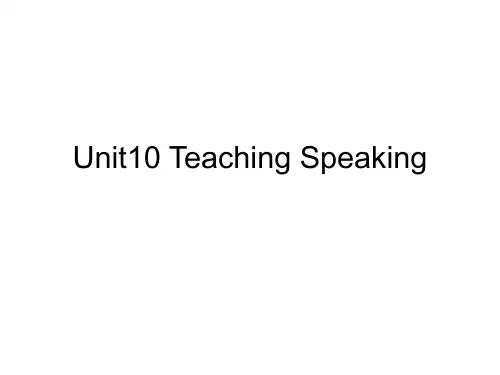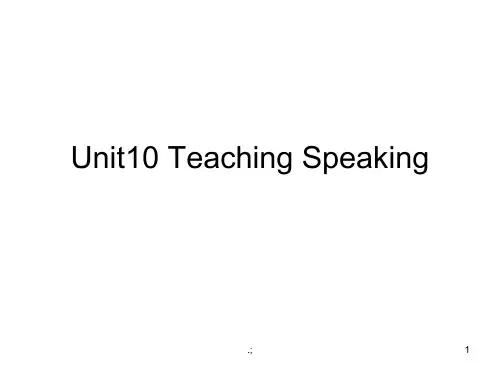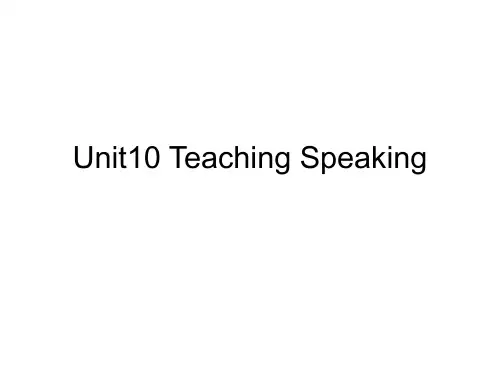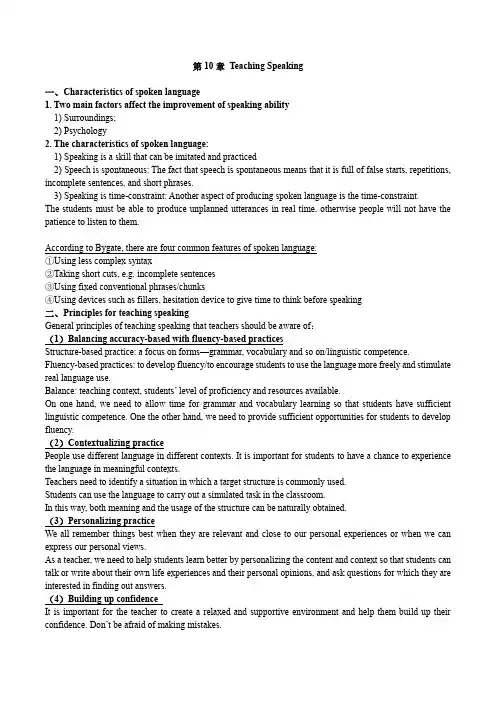英语教学法教程PPTunit10
- 格式:ppt
- 大小:350.00 KB
- 文档页数:28


![最新[英语学习]英语第10章PPT课件](https://uimg.taocdn.com/903d63843c1ec5da51e2700c.webp)





![英语教学法Unit10 Teaching Speaking[精]](https://uimg.taocdn.com/964c146feff9aef8941e06e0.webp)


第10章Teaching Speaking一、Characteristics of spoken language1. Two main factors affect the improvement of speaking ability1) Surroundings;2) Psychology2. The characteristics of spoken language:1) Speaking is a skill that can be imitated and practiced2) Speech is spontaneous: The fact that speech is spontaneous means that it is full of false starts, repetitions, incomplete sentences, and short phrases.3) Speaking is time-constraint: Another aspect of producing spoken language is the time-constraint.The students must be able to produce unplanned utterances in real time, otherwise people will not have the patience to listen to them.According to Bygate, there are four common features of spoken language:①Using less complex syntax②Taking short cuts, e.g. incomplete sentences③Using fixed conventional phrases/chunks④Using devices such as fillers, hesitation device to give time to think before speaking二、Principles for teaching speakingGeneral principles of teaching speaking that teachers should be aware of:(1)Balancing accuracy-based with fluency-based practicesStructure-based practice: a focus on forms—grammar, vocabulary and so on/linguistic competence.Fluency-based practices: to develop fluency/to encourage students to use the language more freely and stimulate real language use.Balance: teaching context, students’ level of proficiency and resources available.On one hand, we need to allow time for grammar and vocabulary learning so that students have sufficient linguistic competence. One the other hand, we need to provide sufficient opportunities for students to develop fluency.(2)Contextualizing practicePeople use different language in different contexts. It is important for students to have a chance to experience the language in meaningful contexts.Teachers need to identify a situation in which a target structure is commonly used.Students can use the language to carry out a simulated task in the classroom.In this way, both meaning and the usage of the structure can be naturally obtained.(3)Personalizing practiceWe all remember things best when they are relevant and close to our personal experiences or when we can express our personal views.As a teacher, we need to help students learn better by personalizing the content and context so that students can talk or write about their own life experiences and their personal opinions, and ask questions for which they are interested in finding out answers.(4)Building up confidenceIt is important for the teacher to create a relaxed and supportive environment and help them build up their confidence. Don’t be afraid of making mistakes.(5)Maximizing meaningful interactionsThe typical classroom interaction is teacher-student interaction initiated by the teacher.Its drawbacks: leaves students in a passive position; students will speak or act only when they are given a question or nominated to do so; not allowing maximum participation among all the students.As one of the main objectives of teaching speaking is to develop students’ ability to initiate a topic, to ask questions, to take turns in speaking, to change topics and to have some control over the communication, it is best practiced within small groups or in pairs. When we design speaking practices, we need to ensure that the interaction is meaningful and participation is maximum.(6)Helping students develop speaking strategiesSpeaking involves strategies, such as initiating a conversation, turn taking, asking for clarification, asking for repetition, getting others’ attention, getting help from others, and ending a conversation, etc.The classroom is the best place where students can become aware of the speaking strategies and practice them consciously in order to use them successfully in real life situations.(7)Using classroom learning environmentMaking the best use of classroom learning environment to provide sufficient language input and practice for the students.In china, students have the opportunity to hear and speak the language only in the classroom. So creating an English speaking environment to maximize learning opportunity is crucial for students.三、Designing speaking tasks1. Two factors considered in designing speaking tasks①When we design speaking tasks, one important consideration is the language proficiency level of the students. If we ask them to do tasks that are above their level, they will simply become frustrated and demotivated.②On the other hand, it is good to give the students tasks at times that challenge them, because if speaking tasks are all was too easy, they can also become demotivated.2. Common characteristics in successful speaking tasks(1)Maximum foreign talkThe students talk a lot in the foreign language. One common problem in speaking activities is that students often produce one or two simple utterances in the foreign language and spend the rest of the time chatting in their native language. Another common problem is that the teacher talks too much of the time, thus taking away valuable practice time from the students.(2)Even participationWhether the task takes place among the whole class or in small groups, a successful task should encourage speaking from as many different students as possible. The task should be designed in a way so that the outspoken students do not dominate discussions. When necessary, the teacher may interfere to guarantee equal opportunities for students of different levels.(3)High motivationMotivation is one of the most important variables in successful language learning.Teachers can do a lot to increase and maintain the motivation of students by the types of tasks that they organize in class.Students are eager to speak, when the topic is interesting or there is a clear objective that must be reached. Again great care should be taken to make sure the task is in line with the students’ ability to deal with. If the task is too easy, the students may think it is childish and thus lose interest.(4)Right language levelIn a successful speaking task, the language is at the right level. The task must be designed so that students can complete the task successfully with the language that they have. If the students lack too much vocabulary the task will become frustrating and the students are likely to give up or revert back to the native language.四、Types of speaking tasksIt is important to give the students a variety of speaking activities so that they will be able to cope with different situations in reality. Variety also helps keep motivation high.1.Two major purposes for listeningOne is to get information and the other is for social reasons. The same is true of speaking.2. Two types of communicative speaking activities:Littlewood summarized the speaking activities as below:Pre-communicative activities are intended to prepare leaners for communicative activities. Structural activities and quasi-communicative activities under the heading of Pre-communicative activities.Functional communicative activities and social interaction activities under the heading of communicative activities3.Classification of speaking activities(口语活动类型)(1)Controlled activitiesMainly focus on form and accuracy. They force students to pay attention to certain structures or functions so that these can be accurately produced.(2)Semi-controlled activitiesSemi-controlled activities focus more on meaning and communication. The teacher still has some control over the language which students are expected to produce but students have more room for their production.(3)Communicative activitiesCommunicative activities allow for real information exchange, which include information gap activities, problem-solving activities, discussions, debates, interviews, fluency-focused games, etc.4. Typical speaking activities:(1) Information-gap activitiesIn information-gap activities, the students have different information and they need to obtain information from each other in order to finish a task.(2) Dialogues and role-plays①Dialogue: A dialogue is always between at least two people, so we can never predict what the other person will say next.②A role-play: A role-play means the students can pretend they are acting as someone else.(3) Activities using picturesAppropriate pictures provide cues, prompts, situations and non-verbal aid for communication.(4) Problem-solving activitiesThis type of activity tends to be productive because there is a clear objective to be reached or problem to be solved.Problem-solving activities require a higher level of language proficiency, however the difficulty level can be controlled somewhat by the topic.(5) Other speaking activities①Find someone who...Stand up and walk around the room. Ask your classmates what they like to do. Once you find someone who likes something, write down his/her name in the blank next to the activity. Continue asking until you have a different name written down for each activity. The first person to fill in all the blanks is the winner.②Change the storyEach student writes a short story or description and underlines all the verbs. The group together makes a list of 20 random verbs. Each group member reads his/her story and pauses at every verb. The group uses one of the random verbs in place of what the group member originally wrote.③Human scrabbleA game using index cards: one letter per card, two cards of each vowel, one card blank. Divide a stack of cards among a group. Teacher calls out a word in English, groups rush to hold up their cards in the right order.五、Organizing speaking tasksThe first characteristic of a successful speaking task is that students talk a lot in the foreign language. This is the strongest argument for using small group work because it increases the time for each student to practise speaking in one lesson.Design small group work for three reasons:①It increases the time for each student to practice speaking in class.②Often students are afraid of making mistakes or losing face or they feel shy speaking a foreign language in front of a whole class.③Speaking in small groups is more natural for students in real life.。